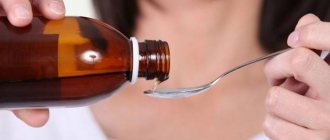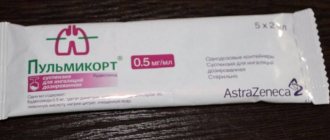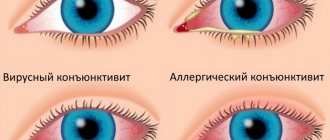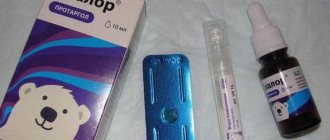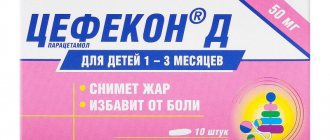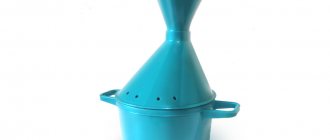Information about the medicine
Vibrocil is available in several dosage forms: drops, gels, spray.
The therapeutic effect of the drug is explained by phenylephrine and dimethindene.
Vibrocil drops are a clear, colorless or yellowish liquid that smells like lavender.
Phenylephrine eliminates swelling of the nasal mucosa and paranasal sinuses.
Dimetindene relieves allergy symptoms.
Vasoconstrictor drops and pregnancy
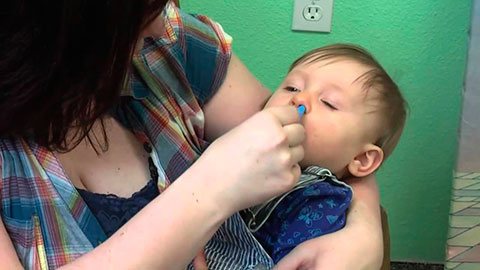
The instructions for Nazivin state that its use during pregnancy is permissible. But doctors recommend using children's drops with a concentration of 0.01%. They should be administered 2-3 times a day, 1-2 drops. The duration of therapy is 3-5 days.
During pregnancy, you should not self-medicate. It is important to consult a doctor so that he can decide on the possibility of using oxymetazoline after assessing the woman’s general condition and finding out whether it is contraindicated for her due to heart and vascular diseases. "Vibrocil" is prohibited during pregnancy, since the effect of dimethindene on the fetus has not been studied.
What should a woman do if she has a runny nose during pregnancy? Cold rhinitis goes away on its own within 5-7 days. Saline solutions can be used to make breathing easier.
The only way to eliminate allergic rhinitis is to neutralize the allergen. If this is not possible, you should contact an allergist to prescribe comprehensive treatment. Most often, hormonal drops are used during pregnancy for hay fever. They are considered safer for the child than vasoconstrictors.
When used correctly, Vibrocil and Nazivin drops effectively help relieve nasal swelling in cases of allergic and viral runny nose in children under one year of age. But they do not cure, they only reduce the severity of the symptom.
For colds in infants and during pregnancy, it is advisable to use saline solutions, and for allergic rhinitis - hormonal agents. In any case, vasoconstrictor drugs can be dripped for no longer than 5-7 days, so as not to disrupt the functioning of the nasal mucosa and not provoke systemic side effects.
Indications
Vibrocil drops are prescribed to children if they are diagnosed with:
- acute rhinitis, including those accompanying a cold;
- runny nose of an allergic nature, including hay fever
- acute and chronic inflammation of the paranasal sinus mucosa;
- neurovegetative rhinitis;
- chronic runny nose;
- acute inflammation of the middle ear.
Drops are used to prepare for surgery in the nasal area or to eliminate swelling of the nasal cavity and paranasal sinuses after surgery.
Indications for use of the drug
The drug is produced in 3 forms:
- Gel is a homogeneous mass with the aroma of lavender, containing no mechanical impurities and having a colorless or pale yellow tint.
- Drops are a clear, colorless or yellowish solution that also has a light lavender aroma.
- Spray - this form of medicine is basically colorless, but may be within a yellowish tint, and has a faint lavender odor.
The active ingredients of the drug are dimethindene and phenylephrine. The use of the gel and spray is possible from the age of 6 years according to the instructions.
Vibrocil drops for children are used to treat infants and children up to one year old.
Vibrocil is prescribed for the following diseases:
- Chronic and acute sinusitis;
- Colds;
- Nasal congestion;
- Hay fever;
- Allergic rhinitis in chronic and acute course.
According to the instructions for use, Vibrocil is used as an adjuvant for the treatment of moderate and acute forms of otitis, as well as in preparation for surgery in the nasal passage. It is used to remove swelling in the nasal cavity after a surgical procedure.
Instructions for use
The dosage of Vibrocil is selected individually depending on the age of the child:
| Age | Single dose in drops |
| 1-6 years | 1-2 |
| Over 6 years old | 3-4 |
You need to drip 3-4 times a day.
Parents should consider the following:
- Before instilling the medicine Vibrocil, you need to clean your nostrils.
- Tilt the child's head back and instill the drug. You need to keep your head in this position for several minutes.
- Treatment with Vibrocil should not last more than 1 week. If you drip the medicine for a long time, it can cause addiction and a “ricochet” effect, the development of drug-induced rhinitis.
- If the signs of the disease do not go away, then you need to show the child to the doctor.
- To prevent the drops from losing their therapeutic effect, they must be stored at temperatures up to 30 degrees for 36 months.
- Vibrocil is not recommended for use if the child is receiving β-blockers, tricyclics, or tetracyclic antidepressants.
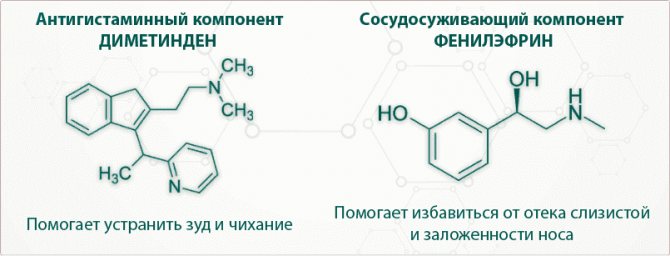
Method of application
Allergic rhinitis often occurs in infants under 1 year of age. This disease is significant even for an adult patient, and therefore for a newborn it is a difficult ordeal. After all, the baby cannot independently clear the mucus from the nose, which causes breathing problems, which threatens oxygen starvation and growth retardation.

In some cases, body temperature rises and sleep disturbances occur. Therefore, it is necessary to promptly identify and eliminate the symptoms of the disease.
Children under 1 year of age suffer more severely from rhinitis due to the fact that they still have very narrow nostrils. For this reason, it is impossible to use sprays and gels.
Vibrocil for children up to one year will help eliminate allergic rhinitis. If you follow the dosage, the combined drug is absolutely safe for the child. Even one drop will clear the nasal cavity of mucus and normalize breathing.
The dosage of the drug for infants is 1 drop in each nostril three times in 24 hours. Drops are used to treat the nasal mucosa before feeding. The therapeutic course lasts 1 week, then you need to take a break. If used for too long, there is a risk of drug-induced rhinitis (a disorder of the nasal mucosa that can only be eliminated with the help of vasoconstrictor drugs).
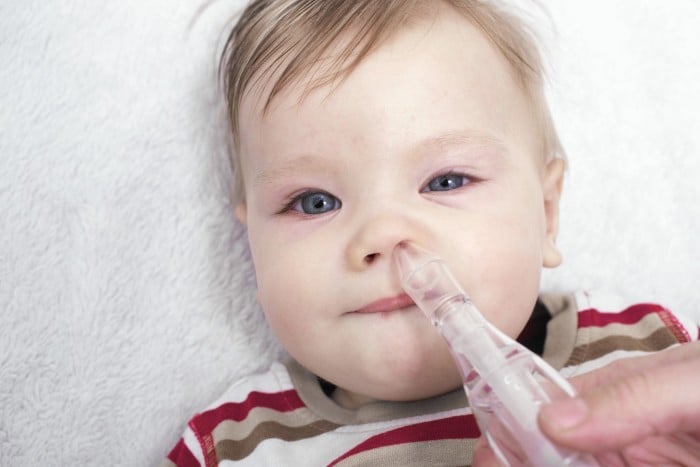
Stages of administering nasal drops:
- The child lies on his back after cleaning the nasal passages with saline solution.
- Turn his head to the right, drop the medicine into the right nostril, and close it.
- After 2 minutes, repeat the procedure for the left nasal passage.
For the smallest children, you can use cotton wool pads soaked in the solution.
Contraindications
Vibrocil drops should not be given to a child who has been diagnosed with the following pathologies:
- allergy to the composition of the medication;
- angle-closure glaucoma;
- chronic runny nose, which is accompanied by atrophy of the nasal mucosa and the nerve endings located here.
Vibrocil should not be instilled into a child if he is undergoing treatment with MAO inhibitors or if it ended less than 2 weeks ago.
The drug should be administered with caution if the patient is diagnosed with the following pathologies:
- hyperfunction of the thyroid gland;
- diabetes;
- epilepsy;
- narrowing of the bladder neck;
- heart rhythm disturbance, multifocal atherosclerosis, arterial hypertension.
The drug should be administered with caution to a child who has a severe reaction to indirect adrenergic agonists, which is manifested by sleep and heart rhythm disturbances, dizziness, increased blood pressure, trembling of the limbs and other parts of the body.
Adverse reactions
Vibrocil drops may cause side effects in a child:
- burning, dryness and discomfort in the nose;
- bleeding from the nasal cavity.
If the child’s undesirable effects worsen or reactions appear that are not described in the instructions, you should tell your doctor about them.
If you instill a vasoconstrictor in dosages higher than therapeutic, this can cause an overdose, which is manifested by the following symptoms:
- occipital pain;
- tachycardia;
- paler skin;
- excessive excitement;
- sleep disturbance;
- dizziness;
- nausea, vomiting, pain in the epigastric region;
- extrasystole;
- trembling of individual parts of the body;
- feeling tired;
- increased blood pressure.
For an overdose of Vibrocil, the antidote is unknown. The child is given activated carbon. Young children are prescribed a laxative; patients over 6 years of age are advised to drink plenty of fluids in case of overdose.
To normalize high blood pressure provoked by phenylephrine, alpha-blockers are prescribed.
Which is better Rinofluimucil or Vibrocil?
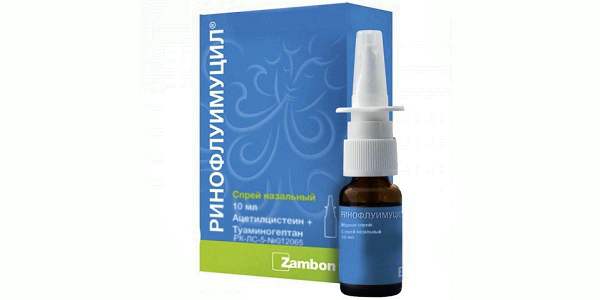
Rinofluimucil is a combination medication that is available in the form of a nasal spray. The drug eliminates swelling of the nasal mucosa, thins purulent mucous secretions in the nasal cavity, relieves inflammation, and normalizes breathing. Rinofluimucil is not used for allergic rhinitis and otitis media. It is contraindicated in cases of intolerance to its composition, hyperthyroidism, and angle-closure glaucoma. Rinofluimucil can be used in children of any age, but for children under 3 years of age, it should be prescribed with caution. Unlike Vibrocil, Rinofluimucil is more likely to cause adverse reactions.
What is better Protargol or Vibrocil?
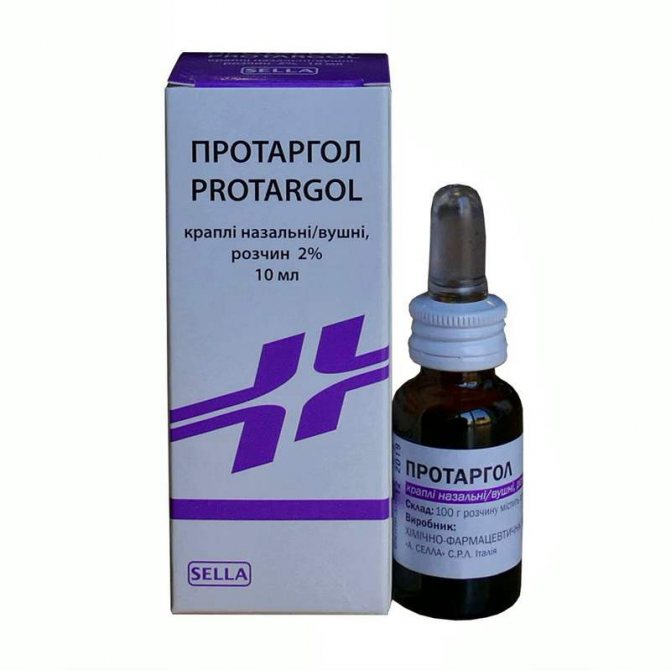
Protargol contains silver proteinate as an active ingredient. The medicine has an antiseptic and anti-inflammatory effect. Protargol prevents bacteria from multiplying on the nasal mucosa. It is used for acute rhinitis and sinusitis. Protargol is contraindicated in case of atrophic rhinitis, allergies to the composition of the medication. The drug acts directly on the cause of rhinitis and sinusitis, and not just as Vibrocil eliminates the symptoms of the disease. But this does not mean that Protargol is better, since it is ineffective for allergic rhinitis and otitis media. In addition, silver proteinate can cause allergies, including Quincke's edema.
Which is better Snoop or Vibrocil?
Snoop is available in a spray, which contains 0.05% and 0.1% xylometazoline as active ingredients. It has the same indications for use as Vibrocil, but Snoop has more contraindications and adverse reactions. It can only be used by children over 2 years old. Due to treatment, they may experience allergies, headaches, difficulty falling asleep, blurred vision, increased heart rate, increased blood pressure, vomiting, depression, dryness, swelling, burning of the nasal mucosa, and sneezing. But the effects of Snoop last longer than those of the phenylephrine-based drug.
Analogues of Vibrocil: it seems similar, but not the same
The medical industry produces drugs with similar effects and drugs whose active ingredient is the component - phenylephrine - but there are no complete analogues of Vibrocil for children .
Preparations based on phenylephrine:
- Nazol kids;
- Nazol baby;
- Polydex with phenylephrine;
- Adrianol.
There are no drugs based on dimetindene for the treatment of runny nose.
Other drugs for the treatment of runny nose are based on:
- xylometazoline (Galazolin, Grippostad Rino, Influrin),
- oxymetazoline (Afrix, Nazivin, Nazol),
- naphazoline (Sanorin, Naphthyzin).
Vibrocil cannot be placed alongside these vasoconstrictors due to the different effects of their components and the impossibility of use in children from birth. For runny noses in children, Vibrocil reduces nasal discharge without inhibiting the physiological functions of the nasal mucosa; it is both a vasoconstrictor and a drug for the treatment of allergies, which is due to the action of its components.
You can learn more about this medicine from this video.
What is better Polydex or Vibrocil?
Polydexa is a combined spray that, in addition to phenylephrine, contains dexamethasone, neomycin, polymyxin B. In addition to the fact that the drug eliminates swelling and normalizes breathing, it also has an antibacterial effect. Polydexa can be used in patients over 2.5 years of age with rhinitis, nasopharyngitis and sinusitis. The medicine has more contraindications than Vibrocil drops. But this does not mean that Polydex spray is worse and perhaps it is more suitable for a particular child.
The doctor should select an analogue of Vibrocil, since each medicine has its own characteristics.
Reviews
Moms and dads opinion
There are a lot of positive reviews about Vibrocil drops on the Internet. Parents like the following about the drug:
- drops are possible from one year onwards;
- After instillation of the drug, the effect occurs quickly, and within 5 minutes nasal breathing normalizes.
Among the shortcomings, parents note the following:
- high price;
- the pipette is inconvenient, it doesn’t pick up drops well and you can’t see how much medicine is flowing out;
- presence of contraindications.
Doctor Komarovsky's opinion
Evgeniy Olegovich believes that vasoconstrictors should be in every home medicine cabinet. In his opinion, Vibrocil is optimal for young children. But it should be used only according to strict indications, when the child has not just a runny nose, but a stuffy nose due to a high temperature or he breathes through his mouth while in a dry and warm room. He also recommends dripping them into the nose for otitis media to eliminate swelling and pain in the ears.
Despite the fact that vasoconstrictor drops are available without a prescription, they must be prescribed by a doctor who will tell you how much Vibrocil to drip to the child.
By
How to use?

The instructions contain the following scheme for using Nazivin:
- for newborns (up to 4 weeks) – 1 drop in each stroke;
- up to a year – 1-2 drops.
Regularity – 2-3 times a day.
The dosage of “Vibrocil” for infants is 1 drop in one nostril 3-4 times a day. The duration of therapy for both drugs is no more than 7 days, but it is better when it does not exceed 3-5 days. In this case, the likelihood of addiction is reduced.
Drops in children are used not planned, but symptomatically: if the required time interval has passed and the nose is breathing normally, there is no need to instill them. It is important not to exceed the dosage and frequency of drug administration, otherwise the risk of side effects increases.
Before instilling drugs, the baby's nasal passages must be cleared of mucus with saline solution and an aspirator. Instructions for administering the medicine:
- Lay the baby on his back.
- Turn its head to the right, drip the solution into the right nasal passage, and squeeze it.
- Wait 1-2 minutes and repeat all manipulations with the left nostril.
For the smallest children, you can drip the product onto cotton pads and place them one by one in the nasal passages.
